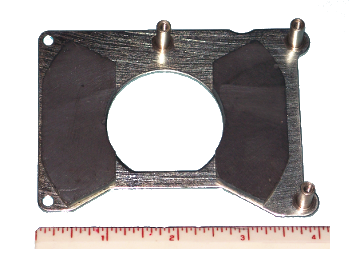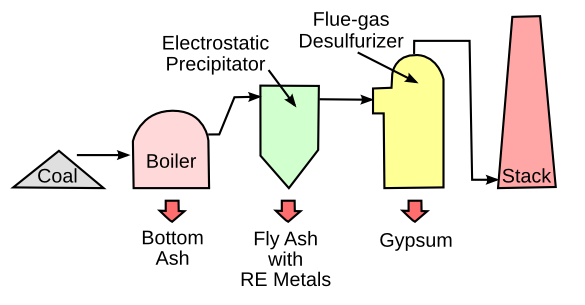Rare Earth Metals from Fly Ash
July 7, 2016
In
graduate school, I once saw a version of the
periodic table called "The Boron Chemist's Periodic Table." My first thought was why would anyone care so much about a single
element to call himself a "
boron chemist." Could such a single-minded chemist be instead called a "
boring chemist?" That aside, the table I saw was distorted to show the boron box many times larger than those of the other elements.
It's not that uncommon for
scientists to identify themselves with the
materials with which they work. I had an enjoyable
post-doctoral position under one of the world's preeminent "rare earth chemists." After working on the
Manhattan Project, nearly every subsequent
publication of this
physical chemist involved one or another of the
rare earth elements.
The rare earth elements are usually defined as
scandium,
yttrium, and the fifteen
lanthanide elements (see figure). The most
technologically useful lanthanides are
lanthanum (La), cerium (Ce), praseodymium (Pr), neodymium (Nd), samarium (Sm), europium (Eu), gadolinium (Gd), terbium (Tb), dysprosium (Dy), ytterbium, and lutetium (Lu).

A good test of an inorganic chemist is whether he can name all of these uncommon elements while looking at just their symbols on the periodic table.
(Created using Inkscape. Click for larger image.)
The rare earths are used in quite a few industrial and
consumer products, such as the
magnets used in
electric motors for
drones and
automobile windows, and for
laser crystals,
catalysts,
phosphors, and
magnetostrictive alloys. As I wrote in several earlier articles (
Rare Earth Shortage, June 21, 2010, and Energy Elements, May 11, 2011),
China controls the world market in rare earth metals, and it has been limiting
exports of these elements (see graph)

World production and Chinese exports, extraction and consumption of rare earth metals. (Translated from a Russian language version on Wikimedia Commons. Click for larger version.)
Since these metals are very useful, many are concerned about their future supply. These elements figure prominently in a
US Department of Energy, December, 2010, report on Critical Minerals,[1] and the American Physical Society (APS) and the Materials Research Society (MRS) have published a joint report on the topic, "Energy Critical Elements: Securing Materials For Emerging Technologies."[2]
So, by what means can we secure a consistent supply of these materials? Recycling is one example, and
computer hard disk drives, now being quickly replaced by
solid state drives, have rare earth magnets as
actuators for their
read/write heads (see photo).
Deposits of rare earths have been discovered in
seafloor mud in the
Pacific Ocean.[3-4]
Economically mining this mud a
mile below the
ocean surface is a problem, but it's not impossible.[5]

Rare earth actuator magnets, mounted on a steel plate, from a hard disk drive
The ruler is in inches.
(Photo by author.)
As it turns out, our
fossil fuel driven
economy is producing a considerable quantity of rare earths by
burning coal.[6-7] In 2010, world coal consumption was about 7.25 billion
tons; and, despite
global warming fears, coal use is expected to rise in the next
decade.
United States coal consumption is about 10% of the world value. The US generates move than a third of its
electricity from coal, producing about 115 million tons of
solid combustion products annually, of which 45 million tons are
fly ash.[6] Fly ash contains mostly
silicon dioxide (SiO2),
aluminum oxide (Al2O3) iron oxide (Fe2O3), and
calcium oxide (CaO), but also trace rare earth metals.
Scientists from
Duke University (Durham, North Carolina) and the
University of Kentucky (Lexington, Kentucky) have just published an
open access article on extraction of rare earth metals from coal fly ash.[6] As shown in the figure, the fly ash is
electrostatically extracted from the airborne products of coal combustion in a
scrubbing chain that removes most
particulates.

Extraction of rare earth metals from flue gas. The rare earths are contained in the fly ash that's extracted in an electrostatic precipitator (Created using Inkscape.)
Says
Heileen Hsu-Kim, an
associate professor of
Civil and Environmental Engineering at Duke University,
"The Department of Energy is investing $20 million into research on extraction technologies for coal wastes, and there is literally billions of dollars' worth of rare earth elements contained in our nation's coal ash... If a program were to move forward, they'd clearly want to pick the coal ash with the highest amount of extractable rare earth elements, and our work is the first comprehensive study to begin surveying the options."[7]
The
research team characterized more than 100
samples of fly ash of varied
geological origin to rank their potential for the recovery of rare earth metals. To assess the total rare earth content, the ash was
dissolved in
hydrofluoric acid, a
hazardous chemical that's not likely to be used in
commercial extraction.[7] It was found that ash from
Appalachian Mountain coal has the highest
concentration of rare earth elements (591
parts per million, ppm), while ash from
Illinois and the
Powder River Basin coal contains 403 ppm and 337 ppm, respectively.[6-7]
Nitric acid could possibly be used in a commercial extraction process, so extraction was tried using this
acid. Appalachian Mountain coal ash is typically encapsulated in a
glassy matrix of
aluminum silicates, which makes it relatively
insoluble in nitric acid, while the Powder River Basin ash dissolved better.[7] The fraction of "critical" rare earth elements (Nd, Eu, Tb, Dy, Y, and Er) in the fly ashes was 34-38% of the total rare earth concentration, which is quite a bit higher than that in conventional
ores (usually less than 15%).[6]
To improve the process, the research team
roasted the coal ash with the
alkali agent,
Na2O2, before dissolving it in nitric acid, and this led to a greatly enhanced yield.[7] It's suggested that roasting the fly ash with
lime might be part of a suitable process.[7] Says Hsu-Kim, "The trick will be exploring our options and developing technologies to drive the costs down. That way we can tap into this vast resource that is currently just sitting around in
disposal ponds."[7] This research was supported by the
National Science Foundation, the
Environmental Research and Education Foundation, and the
American Coal Ash Association.[7]

Shaken, not stirred.
Coal ash samples undergoing a laboratory acid extraction of the rare earth elements.
(Duke University image by Heileen Hsu-Kim.)
References:
- Critical Minerals Strategy (US Department of Energy, December, 2010). A more recent assessment, in draft form, can be found here.
- Energy Critical Elements: Securing Materials for Emerging Technologies, A Report from the APS Panel on Public Affairs Committee and the Materials Research Society (MRS), February 2011.
- Yasuhiro Kato, Koichiro Fujinaga, Kentaro Nakamura, Yutaro Takaya, Kenichi Kitamura, Junichiro Ohta, Ryuichi Toda, Takuya Nakashima, and Hikaru Iwamori, "Deep-sea mud in the Pacific Ocean as a potential resource for rare-earth elements," Nature Geoscience, vol. 4, no. 8 (August, 2011), pp. 535-539, doi:10.1038/ngeo1185.
- Nicola Jones, "Sea holds treasure trove of rare-earth elements," Nature News. July 3, 2011, doi:10.1038/news.2011.393.
- Mission 2016: Strategic Mineral Management - Deep Sea Mining, MIT Web Site.
- Ross K. Taggart, James C. Hower, Gary S. Dwyer, and Heileen Hsu-Kim, "Trends in the Rare Earth Element Content of U.S.-Based Coal Combustion Fly Ashes," Environ. Sci. Technol., (In Press, May 26, 2016), DOI: 10.1021/acs.est.6b00085. This is an open-access publication with a PDF file here.
- Ken Kingery, "Appalachian Coal Ash Richest in Rare Earth Elements," Duke University Press Release, May 27, 2016.
Permanent Link to this article
Linked Keywords: Graduate school; periodic table; chemical element; boron; chemist; boredom; boring; scientist; material; postdoctoral research; post-doc; Manhattan Project; academic publishing; publication; physical chemistry; physical chemist; rare earth element; scandium; yttrium; lanthanide element; technology; technological; lanthanum; cerium; praseodymium; neodymium; samarium; europium; gadolinium; terbium; dysprosium; ytterbium; lutetium; inorganic chemistry; inorganic chemist; symbol; Inkscape; industry; industrial; consumer; product; rare-earth magnet; electric motor; unmanned aerial vehicle; drone; automobile; window; laser; crystal; catalysis; catalyst; phosphor; magnetostriction; magnetostrictive alloy; People's Republic of China; metal; export; production; Chinese exports; mining; extraction; consumption; rare earth metal; translation; translate; Russian language; Wikimedia Commons; United States Department of Energy; American Physical Society; Materials Research Society; recycling; recycle; computer; hard disk drive; solid state drive; actuator; read/write head; mineral; deposit; seabed; seafloor; mud; Pacific Ocean; economics; economical; mining; mile; ocean; magnet; steel; ruler; inch; fossil fuel; combustion; burning; coal; ton; global warming; decade; United States; electricity; solid; fly ash; silicon dioxide (SiO2); aluminum oxide (Al2O3); iron oxide (Fe2O3); calcium oxide (CaO); Duke University (Durham, North Carolina); University of Kentucky (Lexington, Kentucky); open access article; Coulomb's law; electrostatic; scrubber; scrubbing; particulate; flue gas; electrostatic precipitator; Heileen Hsu-Kim; associate professor; Civil and Environmental Engineering at Duke University; research; sample; geology; geological; dissolution; dissolve; hydrofluoric acid; hazardous chemical; commerce; commercial; Appalachian Mountains; concentration; parts per million; Illinois; Powder River Basin; nitric acid; acid; glass; aluminum silicate; solubility; insoluble; ore; roasting; alkali; sodium peroxide; Na2O2; lime; tailings; disposal pond; National Science Foundation; Environmental Research and Education Foundation; American Coal Ash Association; Shaken, not stirred; coal ash